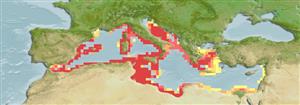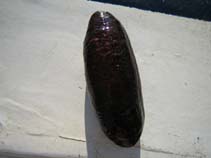Holothuria poli Delle Chiaje
White spot cucumber| Native range | All suitable habitat | Point map | Year 2050 |

|
| This map was computer-generated and has not yet been reviewed. |
| Holothuria poli AquaMaps Data sources: GBIF OBIS |
Classification / Names Common names | Synonyms | CoL | ITIS | WoRMS
| Holothuriida | Holothuriidae
Environment: milieu / climate zone / depth range / distribution range Ekologi
; djupintervall 0 - 250 m (Ref. 85345). Subtropical
Utbredning Länder | FAO områden | Ekosystem | Förekomster | Utplanteringar
Atlantic and the Mediterranean Sea: Algeria.
Length at first maturity / Size / Vikt / Age
Maturity: Lm ? range ? - ? cm Max length : 20.0 cm TL hane/ej könsbestämd; (Ref. 358)
Short description Morfologi
Maximum size: 20 cm. Body: with more or less round cross section; is provided with the ventral face with 3 lines with podia with suction cups. Tegument: constellated with multiple papillae. Color: supported black; papillae being very of an immaculate white. Absence of tubes of Vat (Ref. 358).
Maximum size: 20 cm. Species presents the small funds until largest the depths, but rare. Habitat: Hard funds and herbaria. Biology: this species is nourished, using its tentacles oral flattened, of various organic fragments. It (charges) literally elements of the ground in its oral opening, located at the back of the body. The animal sorts the edible organic substances, and rejects the elements not metabolized such as sand, in the form of roved excrements (Ref. 358).
Life cycle and mating behavior Könsmognad | Reproduktion | Lek | Ägg | Fecundity | Larver
Members of the class Holothuroidea are gonochoric and have only one gonad. Spawning and fertilization are both external and some exhibit brooding. Life cycle: Embryos develop into planktotrophic larvae (auricularia) then into doliolaria (barrel-shaped stage) which later metamorphose into juvenile sea cucumbers.
Main reference
referenser | Koordinator | Medarbetare
Göthel, H. 1992. (Ref. 358)
IUCN Red List Status (Ref. 130435)
Least Concern (LC) ; Date assessed: 19 May 2010
CITES status (Ref. 108899)
Not Evaluated
CMS (Ref. 116361)
Not Evaluated
Threat to humans
Human uses
| FishSource |
Verktyg
Ytterligare information
Internet-källor
BHL | BOLD Systems | CISTI | DiscoverLife | FAO(Publication : search) | Fishipedia | GenBank (genome, nucleotide) | GloBI | Gomexsi | Google Books | Google Scholar | Google | PubMed | Tree of Life | Wikipedia (Go, sök) | Zoological Record
Estimates based on models
Preferred temperature
(Ref. 115969): 13.3 - 18.4, mean 14.9 (based on 106 cells).
Resiliens
(Ref. 69278):
Hög, lägsta populationsfördubblingstid mindre än 15 månader (K=0.69).
Price category
(Ref. 80766):
Unknown.



